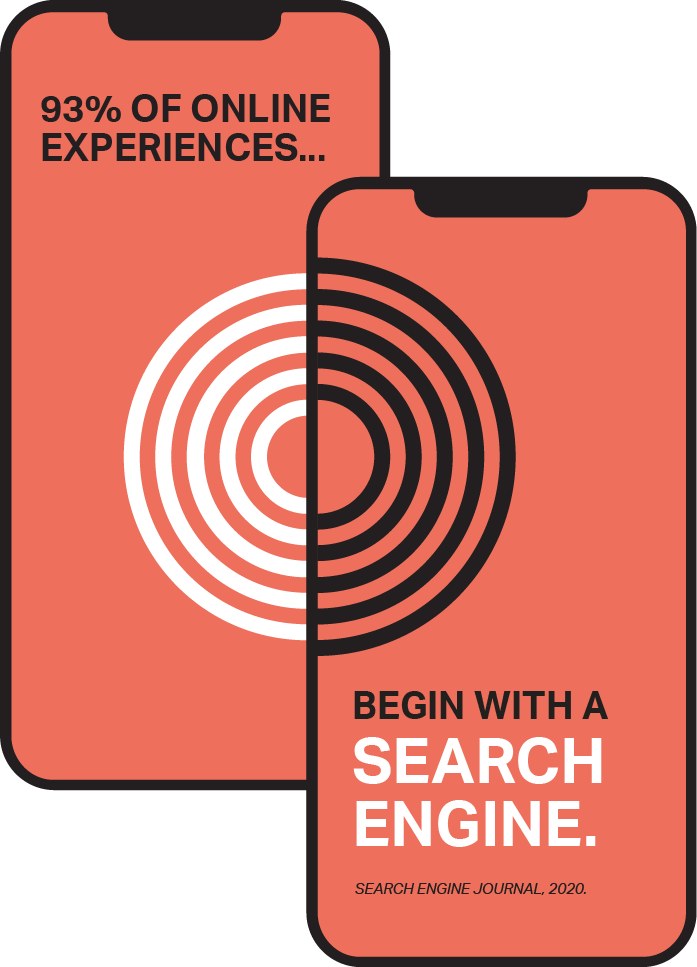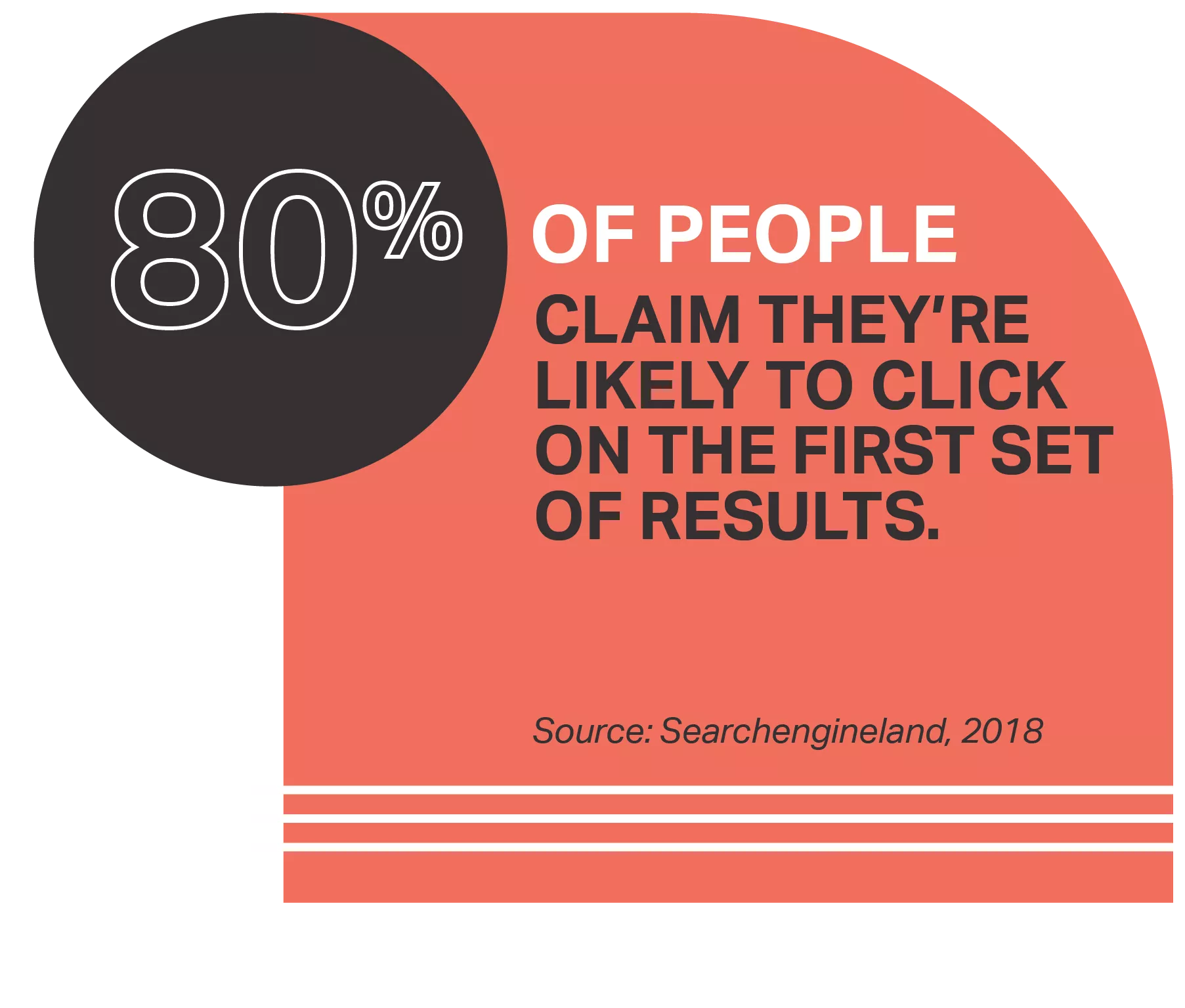What do you need from an SEM agency? ROI.
Search engines have become a daily fundamental in our lives. So much so that one has even become an official verb in the English dictionary (you know the one we’re talking about).
Google processes over 3.5 billion searches per day. PER. DAY. That’s 40,000 per second. That’s an overwhelming number of opportunities for your brand’s name to be seen by consumers through the execution of search engine marketing (SEM).
Google processes over 3.5 billion searches per day. PER. DAY. That’s 40,000 per second. That’s an overwhelming number of opportunities for your brand’s name to be seen by consumers through the execution of search engine marketing (SEM).
Talk to a strategistSearch engines?
There are more than you think.












Pay-per-click.
Pay-per-click (PPC) advertising is a fruitful digital marketing tactic that, if planned and executed properly, can be a big contributor to your company’s growth, whether your objective is brand awareness or conversions & sales. But, as more players enter the game, competition for that top search engine result page (SERP) grows more and more fierce. It is no longer efficient or cost-effective to only bid for your most basic keywords and expect to see results. SEM now requires more strategic thinking including mobile/device-specific targeting and audience mapping. With our team’s 20+ years of digital experience, we know a thing or two about that.
Tell me moreSEM is more than just Google.
If your current SEM strategy (or plans for one) involves sinking your entire budget into Google, we get it. After all, they dominate about 88% of the current search engine market share. However, you’d be closing yourself off to the wealth of opportunities that the rest of the market provides.
Did you know that, depending on your industry, Bing could provide a higher conversion rate than that of its mogul competitor? Or that, if you sell a product, 66% of product searches are done through Amazon? SEM demands thorough research into your user persona, their buying habits and what platforms they are using to conduct their searches. Through strategic media planning and buying, we ensure that the right people are seeing your brand in the right places throughout your SEM execution.
Growth hack.
Most marketers don’t realise searches are collated into ‘intent audiences’. Cross-reference your analytics and existing audience buckets to highly target your search engine marketing and generate exponential RoAS (return on ad spend).
Talk to a strategist
Turning SEM into ROI.
80%
CPA reduction.
51%
increase dwell time.
25%
CPA reduction.
80%
website traffic.
SEM and SEO,
it’s a love-love relationship.
When it comes to ranking on search engines, SEM is more than the highest bidder getting the highest spot. In order to level out the playing field and provide customers with the information they actually want, search engines base your SERP spot on AdRank. AdRank is determined by not only the bid amount but also your relevance to the searcher. Enter one of SEM’s closest friends, SEO.
Through the optimisation of all elements of your site (image SEO, video SEO, voice searchability, etc.), an SEM execution is truly able to shine. Creating relevant content that is valuable to your target audience is key to receiving the top spot on search engines and maintaining it. This also allows us to confidently attribute which of your keywords are performing the best in accordance with your campaign objective. From here, we can implement our True philosophy for digital media: optimise, revise, repeat.
Tell me more
We know the
SEM-antics.
SEM is a strategy where being a step ahead of not only your competitors, but also your consumers is crucial. In 2013, Google released the Hummingbird algorithm, which placed heavy importance on related and interconnected content, and rewarded the pages that met this standard.
This means search engines are becoming increasingly focused on providing a more human experience and giving consumers more contextual information to keep them on the platform longer.Having people in the field that are familiar with the semantics of search engines and keyword/search intent will exponentially increase your chances of being successful. With True’s local experts’ 20+ years digital experience with optimizing SEM campaigns, you can rest assured yours is in good hands.
Talk to a strategistJoin us for a True SEM-inar.
We don’t mean this as a positive affirmation (although, it can be if you want it to be). Identifying and capitalising on trends can provide a valuable return on your SEM strategy. For example, if you worked for a shoe company and everyone starts wearing high top shoes, we would start targeting longtail intent phrases such as ‘where can I buy high top shoes’. This would then lead a customer to a relevant product page. On one hand, executing this practice will allow you to reap the rewards of catching the trend early. But what is perhaps more satisfying is you will be a step ahead of your competitors before these keywords become more expensive.
Dayparting is a tactic that we often see under-utilised by brands. This involves scheduling your ads to be visible at certain times in the day. This can greatly assist your ambition in increasing ROI and help limit your wastage in advertising at non-optimal times. This goes beyond just adjusting your bidding at specific times. It can also be a matter of switching up your messaging to cater to people’s behaviours throughout the day. As a quick example, a potential customer might be hesitant to make a phone call during nighttime hours, if this is the current copy on your PPC ads. In this case, changing your CTA to filling out a contact form could nurture this lead more appropriately. Taking time into account in your SEM strategy and making small tweaks like this can increase your likelihood of conversion.
One of the most overlooked elements of PPC by agencies is the reduction of click fraud. On average 20% of your budget is lost to some variety of fraud. This can range from competitors and brand haters to bots and click farms. This has a massive impact on your analytics and return on investment. Let’s just say you spend $10k on a PPC campaign and it generates a ROI of 5:1. Not only have you lost $2k from your initial stake, you’ve also missed out on a potential $10k in revenue on top of that. Just from click fraud. Crazy, right? That’s why True arms its clients’ campaigns with click-fraud technology and a media strategy that limits wastage.